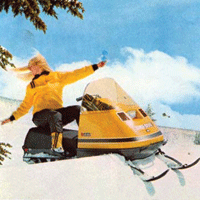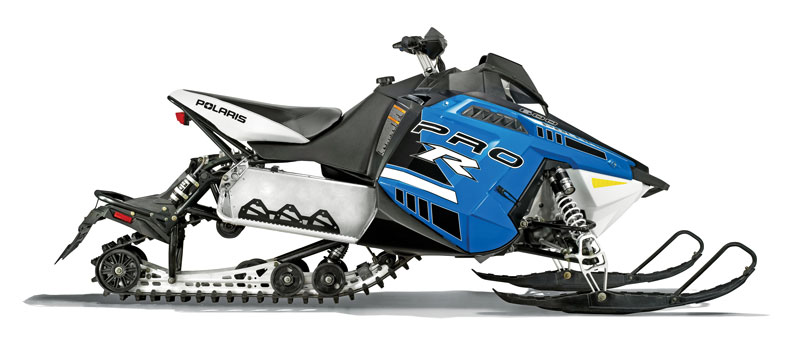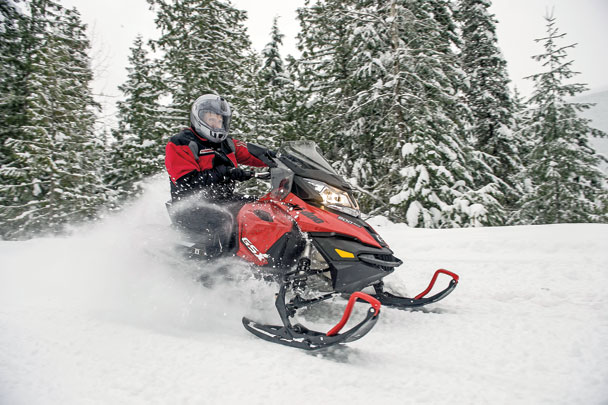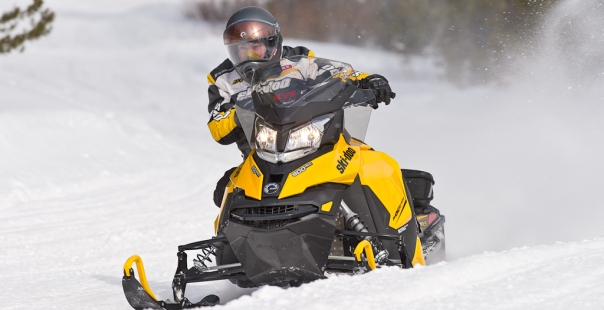Some of the earliest snowmobiles were booted with wood skis, which were expected to provide a lot of flotation. The snowmobile skis did little for handling, though.
The first Ski-Doo had birch skis that were 5 feet long, 5 inches wide and flat-bottomed. The steering spindles that mounted the skis had little caster angle that kept the ski quite flat in a turn, which was important because you didn’t want to pop out one of those wood screws in a hard turn. Ski-Doo’s wood ski was also equipped with a steel runner that was intended to reduce wear of the ski, not enhance handling.
Steel quickly took over as the material of choice for skis. To keep the ski both strong and light, various shapes were stamped into the cross section of the ski to stiffen them. They were equipped with a replaceable bar to control wear, too. In the 1960s, skis generally became shorter and people began to experiment with different profiles to enhance turning.
The center of skis became deeper, forming a keel, and the channel in the center of the ski blade became more rectangular to provide “sharper” cutting edges and more vertical surface when turned in the snow. Not much happened to the design of wear bars in the 1960s, but racers were beginning to experiment with different things to increase the bite in a turn on harder surfaces to allow higher speeds in turns.
Around 1971, a Ski-Dooracing team came up with a wear bar design that used a 1/2-inch diameter bar ‘V’ groove they milled down the center. The bar provided two cutting edges that held well in the turns. The major problem was keeping the bar sharp.
Bombardier liked the design but went one step further and brazed carbide inserts into the milled ‘V’ groove. Bombardier patented the carbide-insert runner and introduced them on the 1972 Ski-Doo Blizzard.
While the fiddling around with wear bar designs was going on, not a lot had happened to the basic ski design. There had been increases in ski leg caster angle to make the skis more aggressive in a turn, but no significant changes had occurred in the shapes of skis with the exception of some strange aftermarket designs that were aimed at specialized markets like racing.
Ski shape as an enhancement to handling didn’t get a big kick again until Gilles Villeneuve introduced his Alouette cockpit, twin-track racer on the Sno-Pro circuit in 1973. His independent front suspension required a ski with a strong cross section. To support it, he simply designed a triangular ski with no flotation. The ski could cut through whatever was on the surface of the track and provide superb cornering traction.
It’s not a ski design that would work well for the average snowmobiler, but it had changed the shape of racing skis. In response, racing organizations had to write restrictions on ski profiles to limit penetration or there would have been machines on the track with knife edges under them.
The next innovation in skis came from USI with the introduction of the first all-plastic ski. With less weight and less friction in many conditions, the USI skis started a revolution throughout the industry.
The handling of a machine is greatly altered by the ski and the runner configuration. No one configuration is the best for every application.
Ski-Doo introduced its Precision ski on its 2002 MX Z, Summit Renegade, Legend SE and Legend GS models. The Precision ski mounted twin carbide runners on an all-plastic ski blade. It also mounted equal length runners at the very outside edges of the all-plastic ski blade. Between the runners was a concave area that packed the snow between the runners. The design literally packed a rail for the ski to follow.
The Precision ski did wonders for the chassis types on which it was initially used. Darting was virtually eliminated and steering was accurate in deep snow and on hardpack. When the REV chassis was introduced for the 2003 model year with its centralized mass, the Precision ski was applied. But the precision that the ski added to the MX Z and other previous chassis types was gone. With less pressure on the ski, darting was reduced, but the ski pushed in loose snow. The engineers knew they had to come up with a new design for the new chassis due to its weight distribution characteristics.
Their solution was the Pilot 5.7 ski for trail sleds and the Pilot 6.9 for mountain sleds, but it didn’t debut until the 2006 model year.
The Pilot skis feature a deep center keel and carbide runner, like a conventional ski, but have an additional shorter keel and carbide on the outside edge of each ski. There is a right and left ski because the short keel and runner must be on the outside edge of each ski. The model numbers of each Pilot ski indicated the width of each at 5.7 inches and 6.9 inches.
Because of the caster angle of the spindles, the skis will roll or lean into a corner when the handlebars are turned. The greater the steering angle of the ski, the more the skis will roll. At low speeds, a larger ski turning angle is generally used. Because the speed is low, there is little weight transfer to the outside ski. In this situation, the outside center keel and runner is in contact while both keels of the inside ski are in contact.
At high speeds, the ski turning angle is generally small and weight transfers to the outside ski. In this situation, both keels of the outside ski are in contact with the trail and have a lot of pressure on them. Both keels of the inside ski are in contact with the trail but have very little pressure on them.
The Pilot 6.9 skis used on the mountain sleds are an offset design and put the additional 1.2 inches to the inside of each ski. This allows an increase of flotation without compromising the vehicle’s width.
Snowmobile skis are now engineered for a specific chassis and have been a major contributor to improved handling with less steering effort and a more confident “bite.” As sled technology continues to advance rapidly, ski development continues to evolve.




